Many people debate whether to use cornmeal or semolina while preparing pasta, pizza, or bread. Both items are well-liked in the culinary world and are versatile.
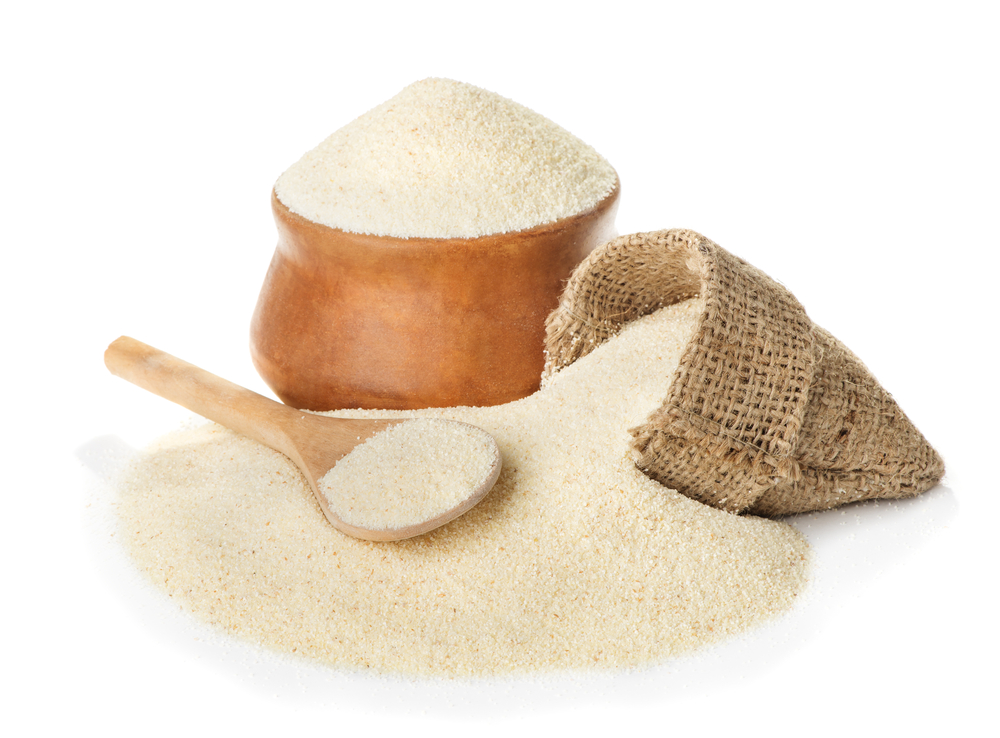
However, they clearly differ from one another, which may have an impact on how your dish turns out.
To assist you in making an informed choice, we will examine the variations, applications, and similarities between semolina and cornmeal in this post.
Durum wheat is used to make the flour used to make semolina. Its hue is yellowish, and its texture is rough.
A lot of people use semolina to make bread, couscous, and pasta. On the other hand, cornmeal, which can be fine, medium, or coarse, is formed from dried corn. It is frequently used to make pizza crust, cornbread, and polenta.
While semolina and cornmeal may have a similar appearance, their texture, flavor, and nutritional content are very different.
We’ll go into more depth about these variations in the sentences that follow to assist you in selecting the finest component for your recipe.
What is Semolina?
Semolina is a type of flour that is made from durum wheat, a hard variety of wheat that is high in protein and gluten.
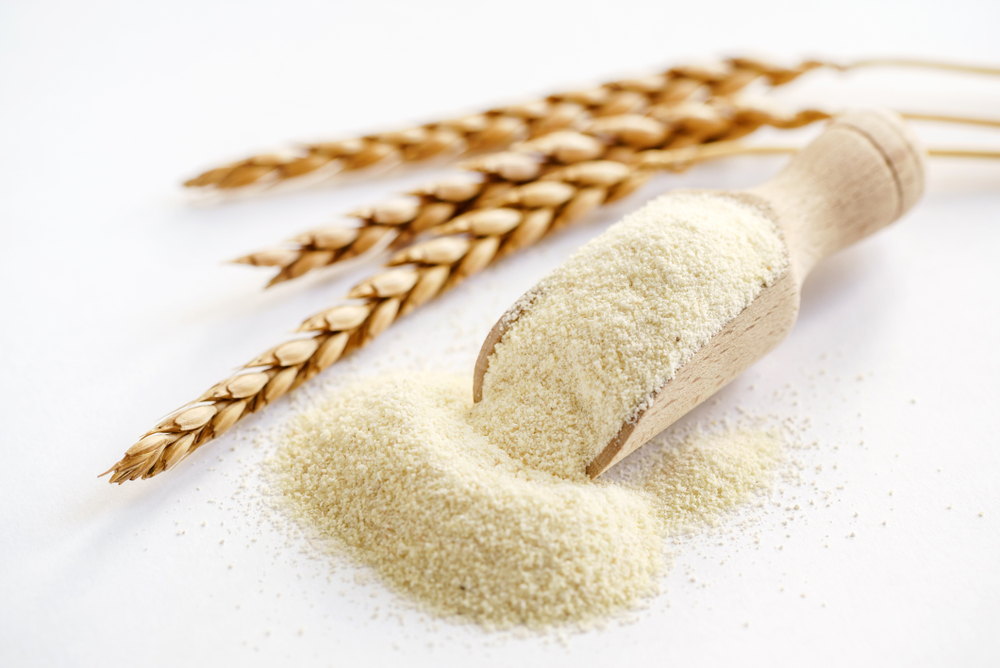
It is a coarse flour that has a slightly yellow color and a rough texture. Semolina is commonly used in the preparation of pasta, couscous, and porridge.
Uses
Semolina is a versatile ingredient that can be used in a variety of ways. It is commonly used in the preparation of pasta, where it is mixed with water and eggs to form a dough that is then rolled out and cut into various shapes.
Semolina is also used in the preparation of couscous, a North African dish that is made from steamed semolina grains. In addition, semolina can be used to make porridge, which is a popular breakfast dish in many parts of the world.
Nutrients
Semolina is a good source of several essential nutrients. It is high in iron, folate, selenium, vitamin B1, vitamin B2, manganese, copper, vitamin B6, vitamin B5, calcium, magnesium, phosphorus, potassium, sodium, and zinc. It also contains small amounts of vitamin A, vitamin E, and vitamin K.
Health Benefits
Semolina is a healthy food that can provide several health benefits. It is a good source of carbohydrates, which can provide energy to the body. Semolina is also high in protein, which can help to build and repair tissues in the body.
It has a low glycemic index, which means that it can help to regulate blood sugar levels. Semolina is also low in fats, saturated fats, and cholesterol, which can help to maintain a healthy heart.
Semolina is a versatile and healthy ingredient that can be used in a variety of ways. It is a good source of essential nutrients and can provide several health benefits when consumed as part of a balanced diet.
What is Cornmeal?
Cornmeal is a type of flour made from ground-dried corn kernels. It comes in different textures, from fine to medium to coarse, and can be used in a variety of dishes. Cornmeal is a staple in many cuisines, including American Southern, Italian, and Mexican.
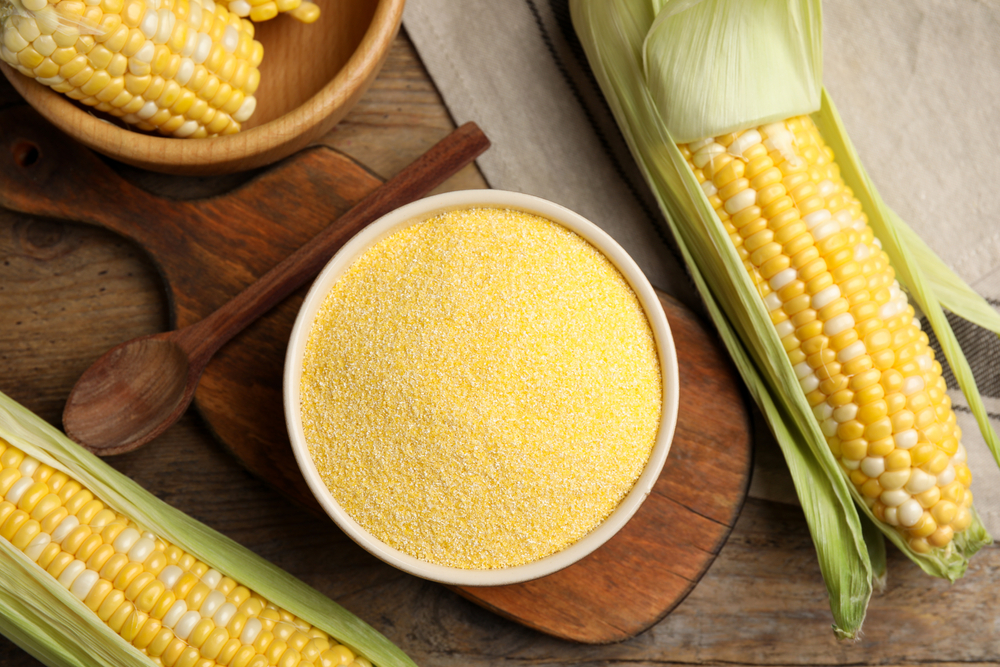
Uses
Cornmeal is a versatile ingredient that can be used in many recipes. It is commonly used to make baked goods such as cakes and bread, as well as cornbread.
Cornmeal can also be used as a coating or dusting for fried foods, or as bread crumbs for meatballs and other dishes. In Italian cuisine, cornmeal is used to make polenta, a dish made by boiling cornmeal in water or stock until it thickens.
Nutrients
Cornmeal is a good source of several nutrients, including iron, vitamin B1, vitamin B5, vitamin C, vitamin E, folate, and manganese. It also contains fiber, which can help with digestion and promote feelings of fullness.
However, it is important to note that cornmeal is high in calories and carbohydrates, so it should be consumed in moderation.
Health Benefits
Cornmeal has several health benefits. The fiber in cornmeal can help lower cholesterol levels and reduce the risk of heart disease. The iron in cornmeal can help prevent anemia, a condition in which the body does not have enough red blood cells.
Additionally, the antioxidants in cornmeal can help protect the body from damage caused by free radicals.
Cornmeal is a nutritious ingredient that can be used in a variety of dishes. Its residue, known as char, can add a crunchy texture and nutty flavor to foods. Grits, a type of cornmeal, are a popular breakfast food in the Southern United States.
Semolina vs Cornmeal: Texture and Taste
When it comes to texture and taste, semolina and cornmeal have distinct differences. Semolina is made from durum wheat and has a finer texture than cornmeal. It is also more granular and has a slightly gritty texture.
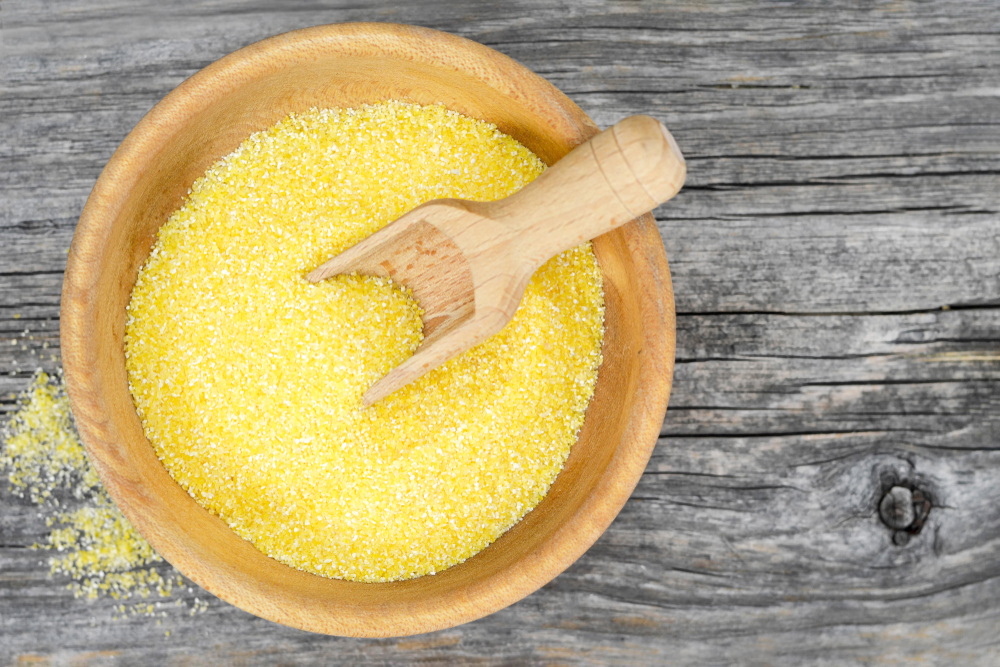
On the other hand, cornmeal is made from dried corn and has a coarser texture than semolina. It is also slightly grainy and has a sandy texture.
In terms of taste, semolina has a mild, earthy flavor that is slightly nutty. It is not as sweet as cornmeal and has a more neutral taste.
Cornmeal, on the other hand, has a distinct corn flavor and is slightly sweet. It also has a more pronounced aroma than semolina.
When it comes to using these two ingredients for pizza crust, the texture, and taste can make a big difference.
Semolina flour creates a chewy, dense crust, while cornmeal creates a crust that is crumbly and soft. The gluten content in semolina flour is also higher than in cornmeal, resulting in a more elastic and stretchy dough.
If you prefer a chewy, dense crust, semolina is the way to go. If you prefer a softer, crumbly crust with a distinct corn flavor, cornmeal is the better choice.
In summary, the texture and taste of semolina and cornmeal are quite different. Semolina has a finer, grittier texture and a mild, earthy flavor, while cornmeal has a coarser, grainier texture and a distinct corn flavor.
When it comes to pizza crust, semolina creates a chewy, dense crust, while cornmeal creates a softer, crumbly crust.
Semolina vs Cornmeal: Uses
When it comes to cooking, semolina, and cornmeal are two popular ingredients that are often used interchangeably.
While they may look similar, they have distinct differences in texture, flavor, and nutritional value. In this section, we will explore the various uses of semolina and cornmeal in cooking.
Pizza
Pizza is one of the most popular dishes that use semolina and cornmeal. Semolina is often used in pizza dough to give it a chewy texture and a slightly sweet flavor.
It also helps prevent the dough from sticking to the pizza peel when transferring it to the oven. On the other hand, cornmeal is often used to dust the pizza peel to prevent sticking and to give the crust a crispy texture.
Bread
Semolina and cornmeal are also used in bread making. Semolina flour is often used in Italian bread recipes to give the bread a chewy texture and a slightly sweet flavor.
It is also used to dust the bread before baking to prevent sticking. Cornmeal, on the other hand, is often used in cornbread recipes to give it a coarse texture and a slightly sweet flavor.
Pies
Semolina and cornmeal are also used in pie making. Semolina is often used in pie crust recipes to give it a crispy texture and a slightly sweet flavor. It is also used to dust the pie pan to prevent sticking.
Cornmeal, on the other hand, is often used in fruit pie recipes to absorb excess moisture and to give the filling a slightly crunchy texture.
Coating
Semolina and cornmeal are often used as coatings for fried foods. Semolina is often used to coat chicken or fish before frying to give it a crispy texture and a slightly sweet flavor.
Cornmeal is often used to coat vegetables before frying to give them a crunchy texture and a slightly sweet flavor.
Dusting
Semolina and cornmeal are also used as dusting agents for various dishes. Semolina is often used to dust baking sheets before baking to prevent sticking.
Cornmeal is often used to dust pizza peels, bread pans, and pie pans to prevent sticking and to give the food a slightly crunchy texture.
Semolina and cornmeal are versatile ingredients that can be used in a variety of dishes. While they have distinct differences, they can be used interchangeably in some recipes.
It’s always best to experiment with different types of flour to find the perfect texture and flavor for your dish.
Semolina vs Cornmeal: Sticking and Handling
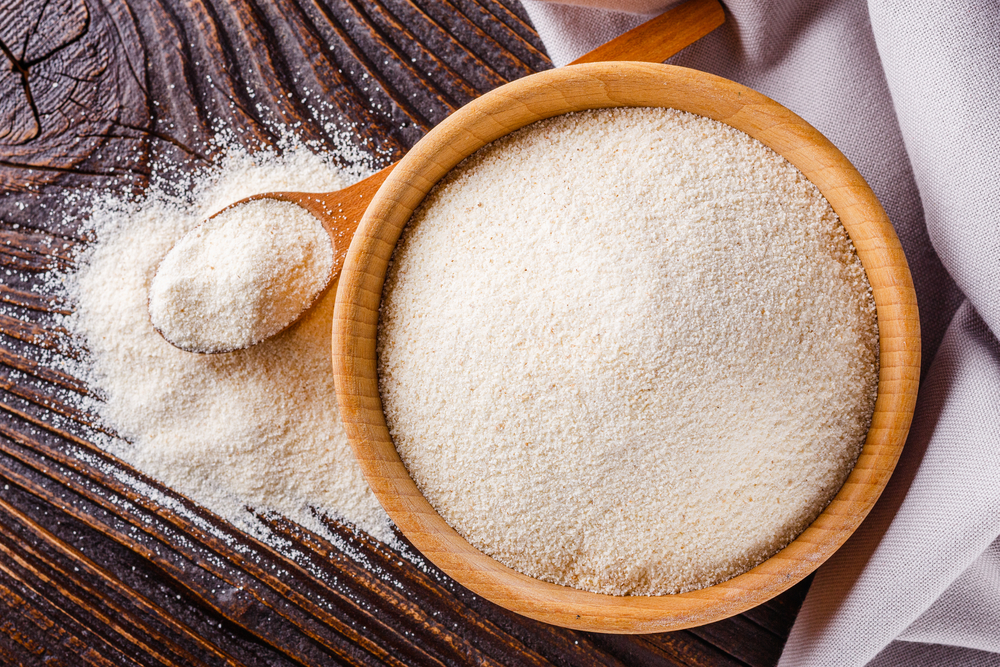
Sticking to the Pan
One of the biggest challenges when making pizza is getting the dough to release from the pan without sticking. Both semolina and cornmeal are popular choices for preventing sticking, but which one is better?
Semolina is a coarsely ground wheat flour that is often used in pasta making. It has a slightly gritty texture that can help prevent sticking and also provides a nice crunch to the crust.
Cornmeal is made from ground corn and has a finer texture. It is also a popular choice for preventing sticking and can add a slightly nutty flavor to the crust.
When it comes to preventing sticking, both semolina and cornmeal are effective. However, semolina is a better choice if you are cooking at high temperatures, as it can handle the heat better than cornmeal.
Cornmeal can burn easily and leave a gritty residue on the pizza stone, which can be difficult to clean.
Handling
Another important factor to consider when choosing between semolina and cornmeal is how easy they are to handle.
Semolina is a coarser flour and can be a bit more difficult to work with than cornmeal. It can make the dough a bit firmer and denser, which can make it harder to shape and stretch.
Cornmeal, on the other hand, is a finer flour and is easier to work with. It can make the dough more pliable and easier to shape and stretch.
However, it can also make the dough a bit softer and more delicate, which can make it more prone to tearing.
However, if you are cooking at high temperatures, semolina is a better choice. If you are looking for flour that is easier to work with, cornmeal may be the way to go.
Semolina vs Cornmeal: Source and Health Risks
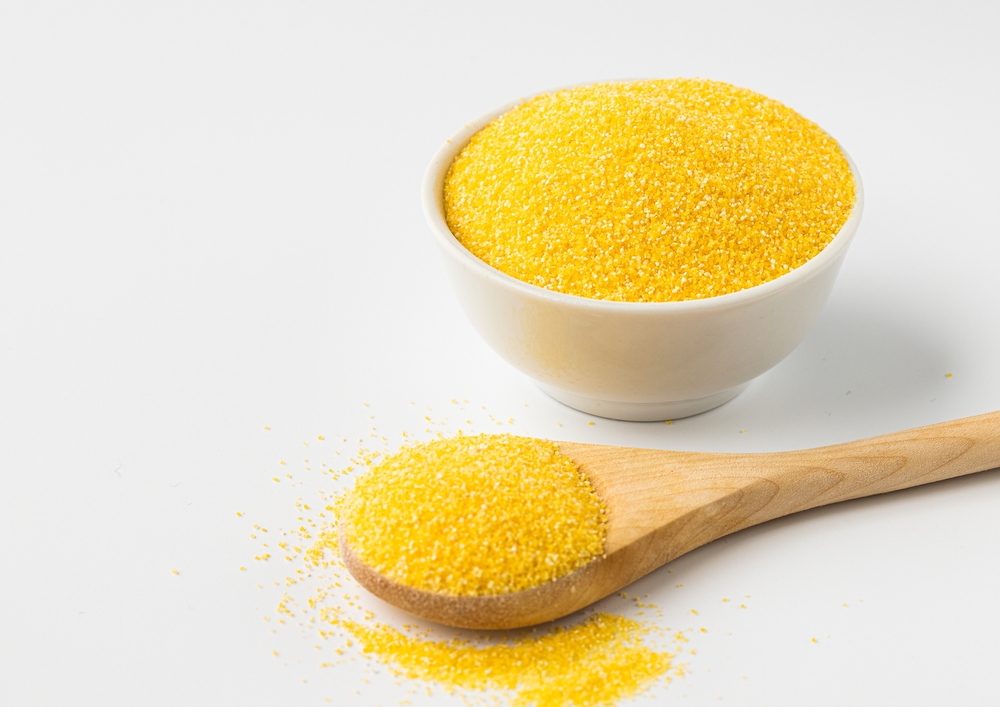
Source
Semolina and cornmeal are both popular ingredients used in various cuisines around the world. Semolina is made from durum wheat, which is a hard wheat variety that is high in protein and gluten.
On the other hand, cornmeal is made from ground corn and comes in different textures, ranging from fine to coarse.
Semolina is commonly used in making pasta, couscous, and bread, while cornmeal is used in making polenta, cornbread, and tortillas. Both semolina and cornmeal are widely available in grocery stores and online.
Health Risks
While semolina and cornmeal are generally safe to consume, there are some health risks associated with their consumption, especially for people with certain health conditions.
One of the main health risks associated with semolina is its high gluten content, which can cause problems for people with gluten intolerance or celiac disease.
Gluten is a protein found in wheat, barley, and rye, and can cause digestive issues, such as bloating, abdominal pain, and diarrhea, in people with gluten intolerance or celiac disease.
Cornmeal, on the other hand, is generally gluten-free, but can still cause digestive issues for some people.
Cornmeal is high in dietary fiber, which can cause bloating, gas, and diarrhea in some people, especially if consumed in large quantities.
Another health risk associated with semolina is its high carbohydrate content, which can cause blood sugar spikes in people with diabetes.
However, semolina is also rich in nutrients like fiber, folate, and magnesium, which can protect the heart and reduce the risk of heart disease.
Cornmeal, on the other hand, is rich in antioxidants, which can protect the body from free radicals and reduce the risk of chronic diseases like cancer and heart disease.
However, cornmeal is also high in carbohydrates, which can cause blood sugar spikes in people with diabetes.
Both semolina and cornmeal have their own unique nutritional profiles and health risks. It’s important to consume them in moderation and consult a healthcare professional if you have any health concerns or dietary restrictions.
Conclusion
After comparing semolina and cornmeal, we have found that both have their unique characteristics and uses. Here are some key takeaways:
- Semolina is a coarse flour made from durum wheat, while cornmeal is a product of corn.
- Semolina is high in gluten and protein, making it ideal for making pasta.
- Cornmeal can be fine, medium, or coarse, depending on the milling process.
- Semolina creates a chewy, dense crust, while cornmeal creates a crust that is crumbly and soft.
- Cornmeal is cheaper and more readily available, while semolina is more expensive but produces a lighter, crunchier, and chewy crust with a sweeter flavor.
- In terms of nutrition, cornmeal is richer in folate, iron, vitamin B1, vitamin B2, and fiber, while semolina is higher in manganese, copper, vitamin B6, selenium, and vitamin B5.
When it comes to making pizza, both semolina, and cornmeal can be used to create a crispy crust. However, the choice between the two ultimately comes down to personal preference.
Some people prefer the nutty flavor and crunchy texture of cornmeal, while others prefer the lighter, sweeter flavor and chewy texture of semolina.
In Nigeria, where semolina is a staple food, it is often used to make a popular dish called semolina porridge.
Meanwhile, cornmeal is commonly used in the United States to make cornbread and other Southern dishes. Both semolina and cornmeal have their own unique characteristics and uses.
We hope this comparison has helped you understand the differences between the two and make an informed decision when choosing which one to use in your next recipe.







Add comment